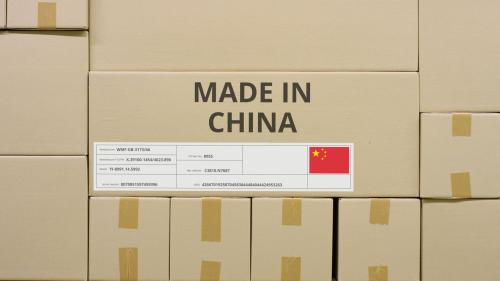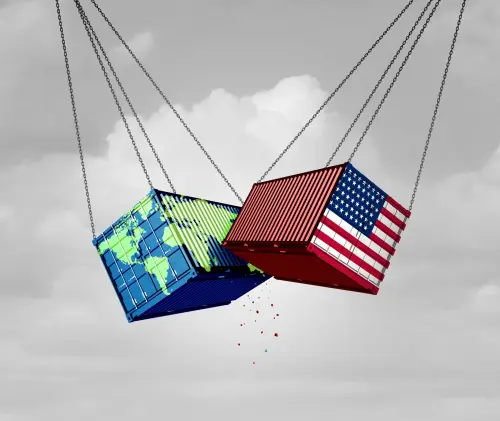On both sides of the Atlantic, economies are showing signs of turmoil: Inflation is at the highest level in more than 40 years, the U.S. stock market has plunged significantly since its peak on January 3, and expectations for a recession are increasing both in the EU and in the U.S., particularly as the Federal Reserve and the European Central Bank are aggressively increasing interest rates to combat inflation. At the same time, the Russian war against Ukraine—with implicit support from China—has underlined the importance of the transatlantic partnership as a democratic bulwark against brutal authoritarian regimes and as a pillar of stability in the world. Policymakers looking for solutions to combat rapidly rising prices—fueled by a mix of supply chain bottlenecks (leading to a shortage of certain goods), rising energy prices, and heightened consumer demand—have largely turned to traditional monetary policy by raising interest rates, risking recession.
However, unfortunately, neither policymakers in the U.S. nor in the EU have so far publicly considered an additional policy measure which could solve several problems at once: to revive and complete an EU-U.S. free trade agreement, building on the Obama administration’s efforts to establish the Transatlantic Trade and Investment Partnership (TTIP). A TTIP successor would not only have the potential to significantly ease existing supply chain woes and reduce inflation in the medium-term but also increase economic growth on both sides of the Atlantic, thereby reducing the risk of a prolonged recession in the U.S. and the EU. While reviving an EU-U.S. free trade agreement will take some time, central bankers now expect that inflation pressures might last longer than expected and that we might not be returning to the low-inflation environment we faced before the pandemic. This underscores the importance of finding other policy measures that curb inflation but do not reduce economic growth. Moreover, an EU-U.S. free trade agreement would lead to greater integration between these two vital blocs, deepening economic and political ties in line with the existing close military ties, increasing regulatory harmonization, and building a more coherent counterweight to the increasingly assertive authoritarian alliance between Russia and China. Reviving a TTIP successor could help improve the economy, reduce inflation, and strengthen ties with our democratic allies.
President Biden would have a good basis to restart negotiations with the EU by building on the far-reaching efforts to implement TTIP by the Obama administration. Before the Trump administration scuttled TTIP and antagonized the EU by imposing tariffs on European goods, President Obama had made significant progress in negotiating an EU-U.S. free trade agreement after launching talks in 2013. The U.S. could pick up where it left off in 2016 by adopting the provisions settled by the initial 15 rounds of negotiations and renewing these talks.
TTIP would have effectively eliminated 98-100% of tariffs, reduced non-tariff barriers to trade with Europe by 10-25%, and been the largest trade deal in history (see Appendix Table 1 for an overview of tariff reductions). Based on estimates of the impact of TTIP on the U.S. economy, wages for high- and low-skilled U.S. workers would have increased, U.S. exports would have spiked, and millions of American jobs would have been created. The deal would have also spurred broad economic growth by increasing U.S. GDP an estimated 0.2-0.4%, or about $75 billion annually.1 For the EU, TTIP would have increased GDP by 0.3-0.5%, or about $64 billion annually.2
Importantly, an often-overlooked benefit of free trade agreements is that they can ease inflationary pressures by streamlining trade between nations, thus increasing the supply of goods and reducing prices. That is, rather than curb demand as interest rate increases do, free trade works through the supply side. Because the current inflation spike can at least partly be attributed to stresses on supply chains, a free trade agreement inducing greater supply would be one step to help ameliorate the magnitude of inflation. By bolstering supply chains, a new free trade agreement would also help relieve shortages of certain goods that have persisted since the pandemic, such as the recent baby formula shortage, and ensure greater access to essential products.
The expected benefits of an EU-U.S. free trade agreement
Economic growth and jobs
The economics behind free trade is clear: Liberalizing trade between two economies increases competition by expanding market access to firms and encouraging firm entry. The lower barriers to entry and resultant increase in competition drives down prices for the consumer and helps to mitigate market concentration. This core argument has been proved by numerous empirical research studies in the past few decades.
While the U.S. does have “most favored nation” status with the EU, American exporters still faced an average 5.2% tariff to the EU in 2018. This was even higher for agricultural products at 12%. Many U.S. industries that ship non-agricultural products could benefit from a free trade agreement as well, including fish and seafood, which incur up to a 26% EU tariff, trucks at 22%, and passenger vehicles and processed wood products, each at 10%.
Reviving a TTIP successor could help improve the economy, reduce inflation, and strengthen ties with our democratic allies.
The effects of TTIP would have been far-reaching because of how large the transatlantic trade market is. A 2014 European report valued all goods and services traded between the EU and the U.S. at 517 and 376 billion euros, respectively. By liberalizing trade, TTIP would have increased total U.S. exports by 11.3% and total U.S. imports by 4.6%, meaning the U.S. trade deficit would have been reduced. Total U.S. exports to Europe would have increased by a staggering 35.7%.
In addition to these broad economic effects, the American worker would have benefitted, too. TTIP would have likely raised wages for low-skilled American workers by 0.4% and for high-skilled American workers by 0.3% (however, these increases in wages would not lead to more expensive goods, since prices would be offset by higher competition and the direct impact of lowering tariffs). Unlike other countries with which the U.S. has free trade agreements, such as Mexico and Colombia, the EU is a high-wage economy. This means American workers would not be directly competing with foreign low-wage workers, alleviating concerns about downward pressure on wages in certain sectors.
To see which industries stand to benefit most from trade economists generally look at trade elasticity, which measures the proportionate increase in demand after a reduction in trade costs allows the price of a good to decrease. Sectors with higher trade elasticities see higher demand for their products as barriers to trade are reduced. Figure 1 shows trade elasticity by sector.3An economic report co-authored by the Atlantic Council estimated that TTIP would have added over 740,000 jobs to the U.S. economy in total, while a Munich-based think tank estimated that 400,000 jobs would have been created in Europe. Analysis of TTIP shows that the motor vehicle, machinery, furniture, computer and electronics, textiles, and food sectors were among those poised to benefit most from the deal, partly due to their trade elasticities and partly due to the types of goods that comprise EU-U.S. trade. Specifically, one German think tank estimated that TTIP would increase U.S. auto exports to the EU by 250%, while an Atlantic Council report said that the U.S. could increase metal manufacturing exports by 125% and processed food exports by 102%. The increase in motor vehicle exports would have been especially important to states in the South and Midwest. (Ohio and Illinois would have gained an estimated 27,000 and 30,000 jobs, and Southern states like Texas and Tennessee would have gained 68,000 and 13,000 jobs, respectively.) The West Coast stood to benefit, as well, as they rely most heavily on services trade with the EU, which makes up over one-third of the total services trade industry in all three West Coast states. In fact, with TTIP, all fifty states would have increased their exports to the EU and created jobs.
Inflation reduction
Biden’s Treasury secretary, Janet Yellen, has stated that increasing free trade could have “desirable” effects on inflation. Indeed, there is evidence that free trade can help reduce inflation through several mechanisms, particularly if it is part of more permanent, structural changes that can help ease inflationary pressures.
Since the bulk of tariffs are paid by consumers, thereby directly raising the price of goods, eliminating tariffs between the EU and the U.S. would directly lower costs for consumers. It is estimated that TTIP would reduce the consumer price index in the EU by 0.3%, and likely by a comparable amount in the U.S. When combined with the estimated long-term increase in real income of 0.4% and 0.5% for these regions, respectively, goods would broadly become more affordable by increasing the purchasing power of the average consumer. Relatedly, there would be lower barriers to entry for both the EU and U.S. markets for their respective companies, allowing potentially greater room for new market entrants, again increasing competition and lowering costs for consumers. As the World Trade Organization (WTO) simply put it, “protectionism is expensive.”
Free trade has historically brought down prices. In the U.S., WTO estimates that the North American Free Trade Agreement (NAFTA) and the Uruguay Round of the General Agreement on Tariffs and Trade, both created in the 1990s, have together increased the purchasing power of the American household by up to $2,000 per year. Certain industries that have been targeted by free trade agreements also demonstrate the benefits of trade liberalization. When the WTO reduced trade barriers on textiles in 2005, clothing prices in Europe fell by 15%. The organization also estimates that protectionist food policies in Europe in the 1990s cost the average family $1,500 per year, while a U.S. tariff levied on sugar in 1988 cost Americans $3 billion in one year. These price increases disproportionately hurt lower-income people, since this cohort spends a larger proportion of their money on goods.
Regulatory harmonization – Lower costs for companies
Another benefit to comprehensive trade deals are the synergies that come with coordinating regulations. Much of the 15 rounds of negotiations for TTIP that took place between 2013 and 2016 were devoted to aligning U.S. and EU regulations on goods that would have been necessary to implement the trade deal. Compatible regulations would have expanded access to trade and relieved bottlenecks in the supply chain due to fewer different regulations a product would have to comply with as it crossed borders en route. It also would have implemented a comprehensive regulatory system to ensure better health, safety, and environmental regulations for products and then leveraged U.S. and EU market power to make these regulations global standards. This also could have helped relieve global economic stress due to COVID-19-related supply chain disruption. This would have been a major accomplishment given how disparate many EU and U.S. regulations are, particularly food safety and environmental regulations. The two trading blocs have different food labelling standards, bans on certain ingredients, and testing and inspection standards to ensure product compliance with health and environmental regulations. These reflect different consumer preferences and even different societal values, and streamlining them is no small feat.
One recent example of incongruous regulations restricting the supply of a good is the baby formula shortage earlier this year. The Food and Drug Administration does not normally permit baby formula to be imported from Europe due to differences in packaging and health requirements. When the supply shortage reached its peak in May due to COVID-related shocks and a recall from formula-producer Abbott, the U.S. military had to fly in an emergency supply of baby formula from Europe. Streamlined regulations could have mitigated the shortage by allowing the import of European formula and potentially prevented this crisis.
Companies would also benefit from these streamlined regulations. One review of TTIP confirmed that preexisting EU and U.S. rules “ensure the same level of safety or quality” but differ in their technical details or enforcement procedures. For example, compliance with two distinct sets of intellectual property regulations have proven particularly burdensome for many businesses that ship between the two trading blocs, and intellectual property-intensive industries account for 60% of U.S. exports. Both sides sought to consolidate and upgrade intellectual property regulations with TTIP, reducing costs for trading businesses and setting a higher global standard while maintaining the rigor of each sides’ preexisting laws.
In addition, legal scholars have argued that legal institutions may stand to benefit as well. U.S. and EU agencies would share information and learn from each other at both upper and lower levels of regulatory authority, creating greater transparency and modernizing regulatory bodies through international engagement. This type of long-standing cooperation could result in the creation of the European equivalent of the United States-Canada Regulatory Cooperation Council, which was formed in 2011. Such collaboration would bolster innovation in U.S. regulation, especially regulation on new and emerging industries for which the U.S. government may currently lack data or information.
Deeper economic integration and cooperation as a bulwark against autocratic regimes
Against the backdrop of increasing authoritarian rule in countries around the world, a weakening of NATO under the Trump administration, and a pandemic that has tested foreign relations, President Biden has said that fortifying EU-U.S. economic ties is essential. This has particularly been the case since the Ukraine war, which led to a rapid and extraordinary response by the EU and the U.S. in the form of economic sanctions against Russia and military aid for Ukraine to support it in the fight against an authoritarian aggressor.
Importantly, on the world stage, democratic nations’ collective economic influence has declined in recent decades. Authoritarian regimes are increasingly able to offer their citizens higher incomes and are becoming a more formidable international presence, both economically and diplomatically. Since President Xi Jingping took over in 2013, China’s GDP has risen from $9.6 trillion to $14.7 trillion. While many democratic UN members are increasingly concerned about a new, emboldened China, some nations are acquiescing to China to reap economic benefits. A trade deal like TTIP would act as a bulwark against nations like Russia and China by highlighting the benefits of democratic principles.
Finally, the war in Ukraine has only strengthened ties between authoritarian nations’ economies, namely Russia and China. While the Chinese government has stated that it remains neutral in the conflict, it also stated that its relationship with Russia has “no limits” just a couple weeks before Russia invaded Ukraine. China has also pushed out pro-Russian propaganda and has had to be warned by the U.S. not to economically or militarily support Russia. China-Russia trade has surged in recent years and is only bolstered by China’s refusal to sanction Russia. Strengthening relations between the world’s two largest economic blocs—the U.S. and the EU—would send a message of economic strength and unity among democratic nations to counter this new axis of authoritarian power.
In addition to these threats, higher level cooperation among allies is needed now more than ever, namely regarding public health and climate change. On climate, collective action and holding each nation responsible for meeting emissions goals is essential. Democratic nations like the United States and Europe are necessary leaders in this fight, and though a trade deal will not solve these issues, it is an agreement based on more than just symbolism that can enable cooperation among our democracies on these issues in addition to economic growth with the right provisions.
Energy supply security
Since the onset of the war in Ukraine, the European Union has banned most Russian oil imports. Russia subsequently temporarily halted gas flowing through a major pipeline to Europe in July. The result is that, while Russia was the largest supplier of natural gas and oil to the EU in 2021, the U.S. has had to ramp up its energy exports to Europe in 2022 to compensate for decreased Russian exports. From January through June of this year, the U.S. exported 39 billion cubic meters of natural gas to Europe. For all of 2021, the U.S. exported only 34 billion cubic meters to the continent.
Higher level cooperation among allies is needed now more than ever, namely regarding public health and climate change.
Significant non-tariff barriers exist that constrain the export of U.S. liquid natural gas to the EU, not the least of which being restrictive U.S. export regulations. TTIP would have increased energy trade by “eliminating all existing restrictions on the export of natural gas.” This meant converging energy regulations and the mutual recognition of testing results to comply with such regulations.
One proposed TTIP provision in particular would have facilitated EU-U.S. energy trade given the current energy issues facing Europe: the energy consultation mechanism. Through this mechanism, an energy shortage would trigger consultations to create a joint evaluation of the situation and the creation of a task force with policymakers, energy industry leaders, and energy experts. Immediately after the war in Ukraine began, this task force could have coordinated energy trade between the two trading blocs to mitigate the ensuing energy woes in the EU.
TTIP also included provisions to bolster the integration of renewable energy markets. Among these provisions were a common set of energy efficiency standards and product design and labeling standards for renewable technology and equipment. The agreement would have also promoted research and development regarding sustainable renewable energy. While these renewable energy provisions were not fully fleshed out by the time TTIP negotiations ended, they could provide a good starting point for renewed talks to help both blocs reach their emission reduction goals.
How to revive an EU-U.S. trade agreement
Restore damaged trade relations and trust between the EU and U.S.
Trade relations between the EU and the U.S. were severely damaged during the Trump administration. After scuttling TTIP, President Trump initially imposed $7.5 billion in annual tariffs on the European Union, affecting imports from aircraft to wine and cheese. The EU retaliated with $4 billion in tariffs on U.S. goods, whereafter Trump imposed $6.7 billion in tariffs on EU aluminum and steel. The EU again retaliated with an additional $3.4 billion in tariffs, with another $4.3 billion set to kick in in June 2021, though this round was suspended in good faith.4 Fortunately, Biden has since dropped the initial $7.5 billion and the EU has subsequently dropped their initial $4 billion in tariffs. And finally, on October 30, 2021, the Biden administration rolled back most tariffs on European steel and aluminum but left some in place. This trade war cost the U.S. hundreds of thousands of jobs (Figure 2).
The Biden administration’s new agreement changed the flat tariffs to a “tariff rate quota,” which imposes tariffs only after a certain amount of European steel is imported. Under this quota, Europe’s first 3.3 million metric tons of steel is imported with no tariff, and all steel thereafter is subject to a 25% tariff. (The EU exported 4.8 million metric tons of steel to the U.S. in 2018.) The new agreement also established a framework to evaluate the carbon footprint of the steel being produced, allowing the U.S. and the EU to produce “clean” steel at a cheaper price. This is in contrast to China’s steel, whose production emits high quantities of greenhouse gases. While the new agreement is a good first step to integrating trade and climate policy, it falls short of restoring trade conditions in aluminum and steel to pre-Trump levels.
Although Biden has met with Europe’s leaders several times and has pledged to begin a new era of cordial relations, he has not fully committed to freer trade with Europe despite the economic costs of increased trade barriers between the EU and the U.S. One estimate put job gains as a result of Trump’s steel and aluminum tariffs (which are in effect taxes on consumers) in the steel and aluminum industries at 26,000, but job losses in the economy as a whole at 433,000, for a net loss of over 400,000 jobs (see Figure 2 below).5 Moreover, by reducing the supply of goods made of steel and aluminum, this policy contributed to a global supply shortage of essential goods in the pandemic.
The higher cost of these metals as a result of the tariffs specifically decreased total jobs in sectors that use aluminum and steel, such as auto manufacturing jobs in the rust belt. This is not surprising when considering simple economic theory predicting that tariffs on a foreign material will increase domestic jobs producing that material (because domestic manufacturers have a comparative advantage), but will reduce the number of jobs that produce goods from the material—like a nail factory or an appliance company—because the overall cost of the material has increased as a result of the tariffs. Businesses often pass down these costs to consumers by raising prices, which in turn decreases demand for its products if demand elasticity is high (meaning consumers are more willing to forego purchasing the product due to the higher price). This job-loss effect as a result of industry shrinkage outweighs the job gains made directly from the tariffs for a net negative effect. The question then begs, why should U.S. jobs in iron, steel and aluminum be more important than jobs in industries that use these raw materials? Rather than based on economic rationale, it turns out that these tariffs were the result of corporate rent-seeking (which is when firms influence economic policy to increase profits) by steel and aluminum companies at the expense of the rest of the economy.
It is therefore imperative for the Biden administration to start further repairing trade relations with the EU and rebuild the mutual trust needed to implement a far-reaching free trade deal between the two blocs. The successful close cooperation between EU leaders and the Biden administration on the response to the Ukraine war and sanctions against Russia is a positive sign that trust between the two sides is starting to be reestablished. President Biden can build on this to negotiate a removal of all tariffs and quotas in aluminum and steel by modifying the current agreement and taking a first step in reviving a successor to TTIP. While the president surely will face resistance from within his own party since industry groups like the American Iron and Steel Institute have urged Biden to keep the tariffs in place, they pose unnecessary impediments for deepening cross-Atlantic economic ties.
Build on previous progress to build the new TTIP
The U.S. is in a good position to revive an EU-U.S. free trade agreement as TTIP was already in its final stages of negotiations when Trump abandoned it. The latest draft included many clauses in advanced stages of negotiations that could be kept, including competition, customs, small enterprise, and dispute clauses (see Table 2 in the appendix). This even applies to agricultural market access, which has been a historic sticking point between the two blocs. Negotiations for TTIP began in 2013 with a “High Level Working Group.” Its goal was to liberalize market access (covering tariffs, investment, and procurement of goods and services), streamline regulatory issues, and address global trade challenges through intellectual property rights, increased competition, and transparency of trading information.
It is imperative that the Biden administration further repair trade relations with the EU and rebuild mutual trust.
By the final, fifteenth round of TTIP negotiations in 2016, both parties had at least partially agreed to the removal of customs duties on industrial products, a draft of agriculture trade framework, definitions of various terms related to service trade, including financial services, rules regarding textile origin verification, streamlined regulation enforcement procedures, pharmaceutical manufacturing inspections, car safety regulations, and a proposal for chemical regulation. Additional ideas, such as an EU proposal to establish a single electronic access point for information on the procurement of certain goods and services, had also been discussed.
Although the proposed agreement achieved its initial goals well, some parts of TTIP would still need significant negotiations, such as the sustainable development clause, which was only in the proposed stage when negotiations ended. However, given the strong commitments to combat climate change by the Biden administration and by the EU, the two blocs are already starting from similar positions on climate and greenhouse gases. Biden’s aluminum and steel agreement, which encourages the production of “clean” steel and makes green materials less expensive and more competitive, as well as the U.S.’s passage of the Inflation Reduction Act and its extensive climate provisions, are indications that these two blocs are closer on environmental concerns than the U.S. and the EU have been in decades.
One example of a recent trade deal that included modernized provisions is the FTA with Japan, which President Trump implemented. Ironically, the effect of this agreement was to give U.S. farmers the same access to the Japanese market as farmers from countries included in the Trans-Pacific Partnership—an Obama-era proposed free trade agreement from which Trump withdrew earlier in his term.6Two-hundred-and-forty-one tariff lines were eliminated, and over 90% of U.S. exports to Japan were allowed to be duty-free or receive preferential tariff status. This included wheat, beef, pork, and other foods. Import tariffs on industrial goods from Japan, in turn, were lowered in the U.S. A separate digital trade agreement addressed priority areas in digital trade including prohibitions on imposing customs duties on digital products transmitted, ensuring barrier-free data transfers in all sectors, and prohibiting data localization requirements to ensure a freer exchange of information and research among the two countries. These stipulations could serve as a template for additional language to include in a new TTIP.
Conclusion
A new TTIP with Europe could help stave off economic stagnation and help drive down inflation, as well as make European-American regulations the global standard-bearer. Former U.S. Ambassador to the EU Anthony Gardner said TTIP would provide an economic equivalent to NATO that would “set the rules of world trade before others do it for us.” With the right provisions, such a deal would better set up this trading bloc to reassert its commitment to tackle climate change, amend labor rights, and protect democratic values on the world stage, leveraging economic power to give it the upper hand in disputes with China and other authoritarian regimes.
Appendix
Table 1
| Negotiating Area | Effect of TTIP |
| Tariffs | 98-100% reduction |
| Non-tariff trade (goods and services) | 10-25% reduction |
| Non-tariff trade (procurement) | 25-50% reduction |
Table 27
| Negotiating Area | Status |
| Agricultural Market Access | Consolidation underway |
| Anti-corruption | US paper |
| Competition | Advanced state of consolidation |
| Cross-Border Trade in Services (CBTS) | Consolidation underway |
| Customs and Trade Facilitation | Advanced state of consolidation |
| E-Commerce | Consolidation underway |
| Energy and Raw Materials (ERM) | EU paper |
| Financial Services | Consolidation underway |
| Investment Protection | EU and US proposals |
| Intellectual Property Rights | EU and US proposals |
| Legal and Institutional | US proposal |
| Market Access/Industrial Goods | Consolidation underway |
| Procurement | Consolidation underway |
| Regulatory Coherence | Consolidation underway |
| Regulatory Cooperation | Consolidation underway |
| Rules of Origin | Consolidation underway |
| Small and Medium-Sized Enterprises (SMEs) | Advanced state of consolidation |
| State-Owned Enterprises (SOEs) | Consolidation underway |
| Sanitary and Phytosanitary Measures (SPS) | Consolidation underway |
| State-to-State Dispute Settlement | Advanced state of consolidation |
| Subsidies | EU proposal |
| Sustainable development: Labor and Environment | EU and US proposals |
| Technical Barriers to Trade (TBT) | Consolidation underway |
| Telecom | Consolidation underway |
| Textiles and Apparel | US proposal |
| Trade Remedies | Consolidation underway |
| Sectors (9) | EU and US proposals and papers |
The Brookings Institution is financed through the support of a diverse array of foundations, corporations, governments, individuals, as well as an endowment. A list of donors can be found in our annual reports published online here. The findings, interpretations, and conclusions in this report are solely those of its author(s) and are not influenced by any donation.
-
Footnotes
- Calculations the author’s own based on: Domènech, Josep Mestres. “The economic impact of the TTIP.” Caixa Bank Research, June 9, 2015. https://www.caixabankresearch.com/en/economic-impact-ttip; The World Bank. “GDP (Current US$).” Accessed October 25, 2021. https://data.worldbank.org/indicator/NY.GDP.MKTP.CD.
- These estimations were done before Brexit, under the assumption that the UK would have been part of the EU and hence TTIP.
- Vandenbussche, Hylke, William Connell, and Wouter Simons. “The Cost of Non-TTIP: a Global Value Chain Approach.” Vives Research Center for Regional Economics, February 2018. https://feb.kuleuven.be/VIVES/publications/discussion_papers/files/vives-discussion-paper-65-the-cost-of-non-ttip-a.pdf.
- This figure ($4.3 billion) is based on the author’s own conversion from euros to dollars using the 2018 average conversion rate. See: Exchange Rates, “Euro to US Dollar Spot Exchange Rates for 2018,” Accessed August 25, 2022, https://www.exchangerates.org.uk/EUR-USD-spot-exchange-rates-history-2018.html#:~:text=Average%20exchange%20rate%20in%202018%3A%201.1811%20USD.
- Trade Partnership Worldwide, LLC. “Policy Brief Round 3: ‘Trade Discussion’ or ‘Trade War’? The Estimated Impacts of Tariffs on Steel and Aluminum.” June 5, 2018. https://tradepartnership.com/wp-content/uploads/2020/10/Trade_and_American_Jobs_2020.pdf.
- The Trans-Pacific Partnership was a major free trade agreement signed in 2016 by 12 Pacific rim countries. The agreement never went into effect and the U.S. officially withdrew from the agreement in January 2017 at the beginning of the Trump administration.
- European Commission. “The Transatlantic Trade and Investment Partnership (TTIP) – State of Play.” April 27, 2016. https://trade.ec.europa.eu/doclib/docs/2016/april/tradoc_154477.pdf.
The Brookings Institution is committed to quality, independence, and impact.
We are supported by a diverse array of funders. In line with our values and policies, each Brookings publication represents the sole views of its author(s).








